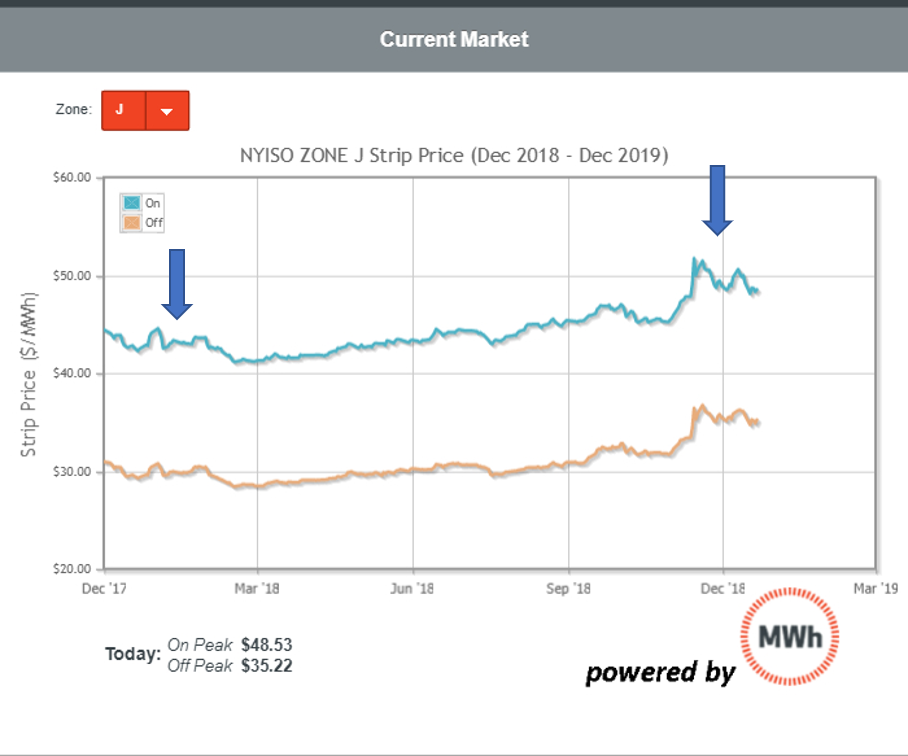As we look back on the major energy trends: 2018 , we see 3 significant issues to watch. What are these energy cost management trends for 2018, and what do they mean to you?

1. Energy Trend 2018 – Return of market volatility
Market volatility returned to forward and day ahead markets at the start of the Winter of 2018 as well as at the end of the year. Cold weather early in January sent markets up, while an early start to Winter in November did the same. Columbia University’s SIPA Center on Global Energy Policy published an article titled “A Closer Look at November’s Big Oil & Gas Price Moves”. The article provides excellent insights into the Fall 2018 market dynamics.
It is worth noting that volatility did not dominate the year. In fact, market spikes were the exception to a year that was largely characterized by little volatility and calm markets. These movements were a wake-up call for all of us who participate in energy markets. The following graph shows how the forward curve for on and off peak power has moved over the past year (all for the same term, December 2018-December 2019). The two volatile “blips” frame months of relatively low volatility.

What does a return of market volatility mean to you?
Customers in deregulated markets are always in the market for power and gas. The volatility that we saw this past year is a reminder that customers can never be complacent about markets and purchasing. The volatility that we saw this past year tended to be short-term. Nevertheless, these market moves were a reminder that it is essential to a) not to panic; b) always have a purchasing strategy in place; and c) re-visit that strategy regularly and make adjustments when necessary.
2. Energy Trend 2018- The power of information.
Despite the bouncy ride that energy markets took this past year, MWh continued to see significant opportunities for improved energy cost management from better utility data and analytics. The MWh team spent more time delving into the low cost, difficult-to-find usage and cost savings available to customers. We found significant opportunities for improvements through small, low-cost measures like: simple operational changes or low-cost peak shaving opportunities. Information available on most customer utility bills can be a goldmine, as we reported here and here.
What does a focus on information mean to you?
Most of the secrets to cost-effective energy management lie in your goldmine of utility data. Don’t delay getting information about your facilities and reviewing it carefully. The insights and value that you can gain from your utility data will get easier to access and more insightful in 2019. The digital transformation of the utility sector will only gain ground in the coming year.
3. Energy Trend 2018- Complexity and transformation
In the span of a few short months in 2018, our customers found themselves navigating tremendous technological complexity. One customer did a deep dive on the value and benefit of on-site co-generation facilities; another broke ground on a battery storage project; a third implemented a campus-wide LED lighting project. All of these customers needed data and information to validate the cost-benefit of these projects, both now and into the future. And none of these customers will be satisfied with static data about the value these projects will bring.
What does complexity and transformation mean to you?
Our advice for navigating all of these trends in 2018 and into 2019 will be the same:
- Use utility data and analytics to create an energy strategy.
- Insist on forward-looking views of usage and cost to evaluate your options.
- Update your strategy frequently based on real data and insights. How frequently should you re-evaluate? We recommend no less than quarterly.
- Review, adjust, evaluate and, most importantly, communicate with your colleagues about changing market dynamics, trends, or technologies that will impact your strategy.
Bottom line for energy and finance professionals: Too often, customers feel as if they are being buffeted by market and technology trends. You have much more control over energy costs than you imagine. Don’t let the market or technology trends drive you. Take control. The first step is to access insights and analytics.
